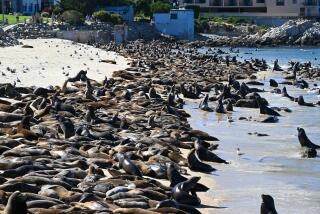Recording the Stone : Culture: Researchers plan to document the rock art painted on San Nicolas Island by ancient Indians. Erosion is erasing the pictographs of whales and fish.
Pounding surf and buffeting winds slowly chip away the sandstone walls of a cave on San Nicolas Island, erasing the only rock art left by a tribe of mysterious ancient islanders.
Many of the whales or fish icons chiseled into the stone are no longer visible. The black painted pictographs can barely be distinguished from the blue-green algae that cling to the crumbling surface.
Archeologists want to protect the artwork from further deterioration at the remote site they call Cave of the Whales. But they cannot figure out how to halt the forces of erosion that have scooped the cave out of the sandstone along the island’s south shore.
So researchers again plan to lug their equipment this week to the Navy-owned island 61 miles off Point Mugu to resume documenting the fading sea creatures that once danced boldly on the cave walls.
They will photograph the grooved petroglyphs, measure the artwork and plot the location of each whale, shark or zigzag line.
In coming months, they may try to capture the faint images with infrared cameras, sample the paint or conduct other tests to glean what they can from the images before they are lost forever.
“This whole cave was covered with rock art,” said Navy archeologist Steve Schwartz, tracing the outline of a dorsal fin with his finger. “I wish we could have seen it in its splendor.”
Most archeologists agree that rock art by Southern California Indians was more than mere doodling. They believe it chronicled a historic event or a celestial phenomenon or portrayed something of religious importance.
“My take is that the art in the cave had something to do with their belief system,” said Kathleen Conti of the Santa Barbara Museum of Natural History. An artist and rock art researcher for 20 years, Conti is leading the first complete documentation of the 40 drawings that can be found in the dimly lit cave.
Once the artwork is thoroughly recorded, she said, researchers can continue to look for clues that might provide insight into the rituals, ceremonies or spiritual beliefs of the Nicoleno Indian tribe.
Little is known about the Nicolenos, who spent thousands of years on San Nicolas until their numbers were diminished in the 1800s during battles with sea otter hunters from the Aleutian Islands and by recruiters for Spanish missions.
The last Nicoleno, a woman left stranded on the island, was brought to the mainland in 1853. Her 18 years of solitude on the island inspired the fictional children’s book “Island of the Blue Dolphins.”
The Nicolenos scratched out a living on the semidesert island by eating mostly shellfish, some roots, sea lions and small fish.
Schwartz points out that none of the usual prey appear in the rock art in the Cave of the Whales. Instead, the petroglyphs outline the features of whales, killer whales, dolphins or sharks.
“There seems to be some important connection to those animals, either spiritual power or that they were more valued than the shellfish which is so much more abundant,” he said.
*
If a whale washed ashore, it would be quite an event on the island, he said. Possibly the artwork depicted such an event or was created to lure more such creatures to its shores. “We think it is hunting magic, connected with the spiritual world,” Schwartz said.
In a 1960 study of the cave, UCLA researchers asked a zoologist to help them identify specific species among the petroglyphs. Other studies also have tried to label each creature.
“It is a fun game to play which animal is which,” Schwartz said. “But I don’t know if any are that successful. It is art, after all.”
In 1962, researchers found a small slab of rock bearing petroglyphs that had slipped off the wall. In 1978, a larger piece fell down.
Both panels are at the Southwest Indian Museum in Highland Park. The smaller panel is on display, clearly showing three grooved petroglyphs of marine creatures. Assistant curator George Kritzman said the cramped museum has no room to display the larger panel, a 2-by-5-foot slab of rock kept in a storage room crowded with other artifacts.
The petroglyphs on both panels are in better shape than those in the rest of the cave because they have been sheltered from the elements.
Despite the erosion, little else seems to have disturbed the rock art on San Nicolas, the most remote of the eight Channel Islands off Southern California.
Access to San Nicolas is tightly controlled by the Navy, which uses the island as a platform for radar and other instruments to track missile testing operations.
Still, there are some initials carved in the walls. Researchers have attributed them to Navy personnel stationed on the island before 1960.
Now, the cave and surrounding beaches--used by sea elephants during their pupping and breeding season--are off limits to the 200 Navy personnel who live and work on the island.
Furthermore, the cave is not easy to find. No trail or markings lead to it. And its entrance cannot easily be seen by anyone walking along the short sandstone cliffs that rise from the ocean.
A grooved petroglyph resembling a shark guards the opening of the cave, which stretches 19 feet across and 9 feet high at the center. The main chamber extends back 35 feet where the walls behind pinch in and the ceiling drops. A narrow passage only a few feet high continues back another 150 feet.
The cave had a sandy floor until about a decade ago when a big storm flushed the sand back to the sea.
A large boulder blocks the surf from flowing freely into the cave. But patches of seaweed litter the rock floor, carried by waves that manage to slop over the rock during the highest tides.
The seaweed also draws swarms of kelp flies and thousands of spiders to feed on them. Black widows lurk in every crack of the cave’s walls and ceilings.
Webs dangle from the ceiling and egg sacs are stuffed into crevices. The cave is filled with the sounds of waves crashing onto the rocks. The sea spray blows into the dank space. Over time, the moisture seeps into the soft sandstone, loosening its sloughing surface.
“There doesn’t seem to be much we can do to stop the erosion,” Schwartz said. “But at least we can record all of the rock art before it disappears.”
More to Read
Sign up for Essential California
The most important California stories and recommendations in your inbox every morning.
You may occasionally receive promotional content from the Los Angeles Times.










